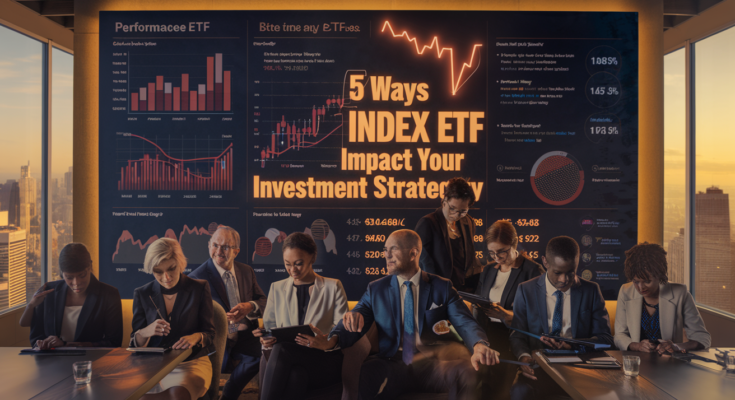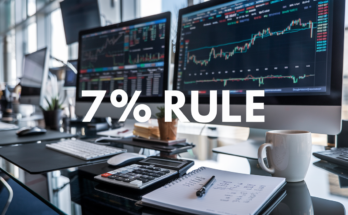Are you tired of the rollercoaster ride that comes with individual stock picking? 🎢 Feeling overwhelmed by the endless stream of financial news and conflicting investment advice? It’s time to take a closer look at index ETFs – the game-changers that are revolutionizing investment strategies for both novice and seasoned investors alike.
Index ETFs have become the secret weapon of many successful investors, offering a simple yet powerful way to diversify your portfolio and potentially boost your returns. But how exactly do these financial instruments impact your investment strategy? 🤔 In this blog post, we’ll explore 5 key ways that index ETFs can transform your approach to investing, helping you navigate the complex world of finance with greater confidence and ease.
Whether you’re a passive investor looking for steady growth or an active trader seeking to fine-tune your strategy, understanding the role of index ETFs is crucial. So, buckle up as we dive into the world of index investing, exploring everything from passive index strategies to Warren Buffett’s time-tested approach. By the end of this post, you’ll have a clear roadmap for leveraging index ETFs to enhance your investment strategy and potentially secure your financial future. Let’s get started! 💪💼
Getting Started
Strategic Question 1: How Are Your Finances?
Before diving into index ETF investing, it’s crucial to assess your current financial situation. This evaluation forms the foundation of your investment strategy and helps determine how much you can comfortably invest without jeopardizing your financial stability.
Start by creating a comprehensive financial snapshot:
- Income: Calculate your total monthly income from all sources.
- Expenses: List and categorize your monthly expenses.
- Debt: Identify any outstanding debts and their interest rates.
- Savings: Determine your current savings and emergency fund.
- Assets: List any valuable assets you own.
Once you have this information, you can better understand your financial health and investment capacity. Here’s a simple table to help you organize your financial snapshot:
| Category | Amount ($) |
|---|---|
| Income | |
| Expenses | |
| Debt | |
| Savings | |
| Assets |
Consider the following questions:
- Do you have a stable income?
- Are your expenses under control?
- Do you have high-interest debt that should be prioritized?
- Is your emergency fund sufficient (typically 3-6 months of expenses)?
Your answers will guide your initial investment decisions. For instance, if you have high-interest debt, it might be wise to focus on paying that off before investing heavily in index ETFs.
Strategic Question 2: What Are Your Financial Goals?
Once you’ve assessed your current financial situation, it’s time to define your financial goals. Clear objectives will help shape your investment strategy and determine which index ETFs align best with your aspirations.
Common financial goals include:
- Retirement savings
- Buying a home
- Funding education
- Building wealth
- Creating passive income
For each goal, consider:
- The target amount you need to achieve
- The timeframe for reaching your goal
- The level of priority compared to other goals
Create a table to visualize your goals:
| Goal | Target Amount ($) | Timeframe | Priority |
|---|---|---|---|
Your goals will influence your investment choices. For example:
- Short-term goals (1-3 years) might benefit from more conservative index ETFs
- Medium-term goals (3-10 years) could utilize a balanced approach
- Long-term goals (10+ years) may allow for more aggressive growth-oriented ETFs
Remember that goals can change over time, so it’s essential to review and adjust your strategy periodically.
Important
Before proceeding, it’s crucial to understand that investing always carries some level of risk. While index ETFs are generally considered less risky than individual stocks, they are not immune to market fluctuations. Here are some key points to keep in mind:
- Diversification: Index ETFs provide built-in diversification, which can help mitigate risk.
- Long-term perspective: Historical data shows that markets tend to rise over the long term, despite short-term volatility.
- Fees matter: Pay attention to expense ratios when selecting index ETFs, as lower fees can significantly impact your returns over time.
- Rebalancing: Regularly review and rebalance your portfolio to maintain your desired asset allocation.
- Stay informed: Keep up with market trends and economic news, but avoid making impulsive decisions based on short-term fluctuations.
Strategic Question 3: What Is Your Risk Tolerance?
Understanding your risk tolerance is crucial for developing an effective investment strategy with index ETFs. Risk tolerance refers to your ability and willingness to endure fluctuations in the value of your investments.
Factors that influence risk tolerance include:
- Age and investment horizon
- Financial responsibilities
- Income stability
- Personal comfort with market volatility
- Overall financial goals
To assess your risk tolerance, consider the following scenarios:
- How would you react if your portfolio lost 20% of its value in a month?
- Are you comfortable with the possibility of short-term losses for potentially higher long-term gains?
- Do you prefer steady, modest growth or are you willing to accept more volatility for the chance of higher returns?
Based on your answers, you can generally categorize your risk tolerance as:
- Conservative: Prioritize capital preservation with steady, low-risk growth
- Moderate: Balance between growth and capital preservation
- Aggressive: Focus on maximum growth, accepting higher volatility
Your risk tolerance will guide your asset allocation strategy. Here’s a simple table illustrating how risk tolerance might influence your index ETF allocation:
| Risk Tolerance | Stocks (%) | Bonds (%) | Cash (%) |
|---|---|---|---|
| Conservative | 30-50 | 40-60 | 10-20 |
| Moderate | 50-70 | 20-40 | 5-15 |
| Aggressive | 70-90 | 10-30 | 0-10 |
Remember that risk tolerance can change over time, so it’s important to reassess periodically and adjust your strategy accordingly.
Strategic Question 4: Can You Handle Market Volatility?
Market volatility is an inherent part of investing, and your ability to weather these fluctuations is crucial for long-term success with index ETFs. This question goes beyond risk tolerance and delves into your emotional and psychological readiness for the ups and downs of the market.
Consider the following aspects:
- Emotional resilience: Can you stay calm and rational during market downturns?
- Long-term perspective: Are you able to focus on your long-term goals despite short-term market noise?
- Discipline: Can you stick to your investment plan and avoid impulsive decisions?
- Financial security: Do you have enough financial stability to avoid selling investments during market lows?
To help gauge your ability to handle market volatility, ask yourself:
- How did you react (or how would you react) during past market crashes?
- Can you resist the urge to constantly check your portfolio’s value?
- Are you able to view market dips as potential buying opportunities rather than cause for panic?
- Do you have a support system or professional advisor to help you maintain perspective during turbulent times?
Strategies for managing market volatility:
- Diversification: Spread investments across different asset classes and sectors
- Dollar-cost averaging: Invest consistently over time to smooth out market fluctuations
- Maintain an emergency fund: Having liquid assets can prevent forced selling during market downturns
- Education: Continuously learn about market behavior and historical trends
- Rebalancing: Regularly adjust your portfolio to maintain your target asset allocation
Here’s a table comparing different investor reactions to market volatility:
| Investor Type | Reaction to Volatility | Long-term Impact |
|---|---|---|
| Panic Seller | Sells during downturns | Potentially significant losses |
| Opportunistic | Buys during dips | May benefit from market recovery |
| Steady | Maintains strategy | Historically favorable outcomes |
By honestly assessing your ability to handle market volatility, you can better prepare yourself for the realities of investing in index ETFs. This self-awareness will help you develop a strategy that aligns with your temperament and financial goals, increasing the likelihood of long-term success.
Now that we’ve explored these crucial strategic questions, you’re better equipped to start building your index ETF investment strategy. The next step is to delve into specific investment approaches that can help you achieve your financial objectives while staying within your risk tolerance and comfort zone.
Strategy 1: Passive Index Investing
Pros and Cons of Passive Index Investing
Passive index investing offers several advantages and drawbacks:
| Pros | Cons |
|---|---|
| Low fees | Limited flexibility |
| Broad diversification | No outperformance potential |
| Simplicity | Market vulnerability |
Who Benefits From Passive Index Investing
Passive index investing is ideal for:
- Long-term investors
- Those seeking low-cost options
- Individuals with limited time for portfolio management
Tip
Consider combining passive index investing with other strategies to create a well-rounded portfolio that aligns with your financial goals and risk tolerance.
Strategy 2: Value Investing
Pros and Cons of Value Investing
Value investing offers potential for high returns but requires patience and research. Here’s a breakdown:
| Pros | Cons |
|---|---|
| Potential for high returns | Time-consuming research |
| Lower risk | Requires patience |
| Margin of safety | Market may not recognize value |
Tip
Look for companies with:
- Low price-to-earnings ratios
- Strong balance sheets
- Consistent dividends
Who Benefits From Value Investing
Value investing suits patient investors who enjoy financial analysis and can weather short-term market fluctuations. It’s ideal for those seeking long-term growth and willing to hold stocks for extended periods.
Strategy 3: Growth Investing
Pros and Cons of Growth Investing
Growth investing focuses on companies with high potential for expansion. Here’s a quick overview:
| Pros | Cons |
|---|---|
| High return potential | Higher volatility |
| Exposure to innovation | Risk of overvaluation |
| Long-term wealth creation | Requires thorough research |
Who Benefits From Growth Investing
Growth investing suits:
- Young investors with long time horizons
- Risk-tolerant individuals
- Those seeking above-average returns
Tip
Diversify your growth portfolio to mitigate risk. Consider blending growth stocks with more stable value stocks for a balanced approach.
Strategy 4: Momentum Investing
Strategy 4: Momentum Investing
Pros and Cons of Momentum Trading
Momentum investing capitalizes on market trends, buying high-performing assets and selling underperformers. Here’s a breakdown:
| Pros | Cons |
|---|---|
| Potential for high returns | Higher risk |
| Capitalizes on market trends | Requires constant monitoring |
| Can work in various markets | Potential for sudden reversals |
Who Benefits From Momentum Investing?
Momentum investing suits:
- Active traders
- Risk-tolerant investors
- Those with time for market analysis
It’s less ideal for conservative investors or those seeking stable, long-term growth. Next, we’ll explore dollar-cost averaging, a strategy that smooths out market volatility.
Strategy 5: Dollar-Cost Averaging
Pros and Cons of Dollar Cost Averaging
Dollar-cost averaging offers several advantages and drawbacks:
| Pros | Cons |
|---|---|
| Reduces market timing risk | May result in lower returns in rising markets |
| Simplifies investing process | Potentially higher transaction costs |
| Minimizes emotional decision-making | Requires discipline and consistency |
Who Benefits From Dollar-Cost Averaging?
Dollar-cost averaging benefits:
- New investors building portfolios
- Risk-averse individuals
- Those with regular income streams
This strategy suits people seeking a systematic approach to investing, regardless of market conditions.
You’ve Picked Your Stategy, Now What?
You’ve Picked Your Stategy, Now What?
Tip
Now that you’ve chosen an investment strategy, it’s time to implement it effectively. Consider these key steps:
- Research thoroughly
- Diversify your portfolio
- Monitor regularly
- Rebalance periodically
| Action | Frequency |
|---|---|
| Review | Monthly |
| Adjust | Quarterly |
Remember, successful investing requires patience and discipline. Stay informed about market trends and economic factors that could impact your chosen strategy. Don’t be afraid to seek professional advice if needed, especially when dealing with complex financial decisions or significant life changes.
How Do I Set Up an Investment Strategy?
Setting Up Your Investment Strategy
To set up an investment strategy, follow these key steps:
- Define your goals
- Assess risk tolerance
- Choose investment vehicles
- Allocate assets
- Monitor and rebalance
Implementation Process
| Step | Action | Importance |
|---|---|---|
| 1 | Goal Setting | High |
| 2 | Risk Assessment | Critical |
| 3 | Vehicle Selection | Medium |
| 4 | Asset Allocation | High |
| 5 | Regular Review | Ongoing |
Setting up an investment strategy requires careful planning and execution. Start by clearly defining your financial goals and assessing your risk tolerance. Then, choose appropriate investment vehicles and allocate your assets accordingly. Finally, regularly monitor and rebalance your portfolio to stay on track.
What Is Warren Buffett’s Investment Strategy?
Warren Buffett’s Investment Strategy
Warren Buffett’s investment strategy focuses on value investing and long-term growth. He looks for:
- Undervalued companies
- Strong fundamentals
- Competitive advantages
- Consistent earnings
| Key Principle | Buffett’s Approach |
|---|---|
| Time Horizon | Long-term |
| Risk Tolerance | Conservative |
| Stock Selection | Quality over quantity |
Buffett emphasizes patience and thorough research. He famously advises investors to “be fearful when others are greedy and greedy when others are fearful,” highlighting his contrarian approach to market sentiment.
How Does Risk Tolerance Affect an Investment Strategy?
How Risk Tolerance Shapes Investment Choices
Risk tolerance significantly influences investment strategy, determining asset allocation and portfolio composition. Investors with high risk tolerance may opt for:
- Growth stocks
- Emerging markets
- Cryptocurrencies
| Risk Tolerance | Typical Investments |
|---|---|
| Low | Bonds, Blue-chips |
| Medium | Balanced funds |
| High | Small-cap stocks |
Conversely, risk-averse investors often prefer stable, income-generating assets. Understanding your risk tolerance is crucial for crafting a sustainable, personalized investment strategy that aligns with your financial goals and comfort level.
What Is the Safest Investment Strategy for Earning High Returns?
Balancing Safety and Returns
While no investment strategy guarantees both safety and high returns, diversification offers a balanced approach. Consider:
- Low-risk options: Treasury bonds, high-yield savings accounts
- Moderate-risk choices: Blue-chip stocks, dividend-paying ETFs
- Higher-risk investments: Growth stocks, real estate
Risk-Return Trade-off
| Risk Level | Potential Return | Examples |
|---|---|---|
| Low | 1-3% | CDs, T-bills |
| Medium | 5-8% | Index funds |
| High | 10%+ | Small-cap stocks |
Remember, higher returns often come with increased risk. Tailor your strategy to your risk tolerance and financial goals.
What Is the Least-Risky Thing to Invest In?
What Is the Least-Risky Thing to Invest In?
When seeking low-risk investments, consider these options:
- High-yield savings accounts
- Certificates of Deposit (CDs)
- U.S. Treasury securities
- Money market funds
| Investment Type | Risk Level | Potential Return |
|---|---|---|
| Savings Account | Very Low | Low |
| CDs | Low | Low to Moderate |
| Treasury Bonds | Low | Moderate |
| Money Market | Low | Low to Moderate |
While these investments offer stability, they typically provide lower returns compared to riskier options. Investors should balance safety with their long-term financial goals when choosing investment vehicles.
The Bottom Line
The Bottom Line
Index ETFs offer diverse investment strategies, each with unique advantages:
- Passive Index Investing: Low-cost, broad market exposure
- Value Investing: Potential for undervalued stocks
- Growth Investing: Focus on high-growth companies
- Momentum Investing: Capitalizing on market trends
- Dollar-Cost Averaging: Consistent investing over time
| Strategy | Risk Level | Potential Return |
|---|---|---|
| Passive | Low | Market average |
| Value | Moderate | Above average |
| Growth | High | High |
| Momentum | High | Variable |
| DCA | Varies | Long-term growth |
Choose a strategy aligned with your goals and risk tolerance. Remember, diversification and regular portfolio review are key to long-term success.
Related Articles
Related Articles
Here are some related articles that may interest you:
- “Understanding ETF Expense Ratios”
- “Active vs. Passive Investing: Pros and Cons”
- “Top 10 Index Funds for Beginners”
| Article Title | Key Focus |
|---|---|
| ETF Basics | Fund structure and benefits |
| Diversification Strategies | Reducing investment risk |
| Tax Efficiency of ETFs | Minimizing tax liabilities |
These articles provide deeper insights into various aspects of ETF investing and related strategies, helping you make more informed investment decisions.
Index ETFs have revolutionized the investment landscape, offering investors a range of strategies to build wealth and achieve their financial goals. From passive index investing to growth and momentum strategies, these versatile instruments provide opportunities for both novice and experienced investors. By understanding and implementing the five key strategies discussed in this article, you can harness the power of index ETFs to create a well-rounded and effective investment portfolio.
Remember, the key to successful investing lies in aligning your chosen strategy with your personal financial goals, risk tolerance, and time horizon. Whether you opt for a hands-off approach with passive investing or prefer a more active role in your portfolio management, index ETFs offer the flexibility and accessibility to suit your needs. As you embark on your investment journey, consider consulting with a financial advisor to help tailor your strategy and maximize your potential for long-term success in the ever-evolving world of finance.




